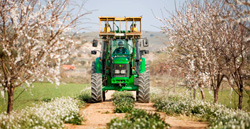Tourism web of Chinchón (Spain)
Activities
The activities that have generated economic resources since the fifteenth century have been mainly agriculture, livestock and related products.
Agriculture
In the primary sector, the main crops are grains, grapes, hemp and olive groves. Making bread as a staple food generated construction and purchase by the City of Chinchon, in the fifteenth century, of several flour mills in the path of Tajuña.
In this century were built the first oil mills which have a remarkable development in the sixteenth century and later, as they increase the olive groves. In the eighteenth century there were 32 oil mills in Chinchón.


Livestock
Livestock was a complement to agriculture, growing up different classes of livestock and poultry such as chickens, pigs, sheep, pigeons, horses, oxen, bees, etc.. household. Pig farming has been very common in Chinchon until the first half of the twentieth century.
The livestock in the area provided the raw material to the tanners and shoemakers. Chinchón been known throughout history three tanneries.
Related products
The weavers and potters shaped their jars and other products related to craftsmen builders and other construction trades.
Garlic and related products began to grow in the eighteenth century, and is currently one of the largest generators of income products in agriculture and temporary jobs.
Wine production is maintained with the designation of origin of Arganda through cooperative society that encompasses most of the growers and their product dispenses red, white, pink and bottled and bulk aging. There is another private company that sells red wines, white and aging.
The initial industry was oriented to agriculture and products. Today is basically oriented towards the construction and services. The lack of a pure excludes industrial processors, generates a disorder in the urban fabric and degrades the aesthetic of the historic artistic.
The winemaking tradition from the fourteenth century, when every grower has his own winery where you get your wine and distilled pomace, gives rise to the distillation of anise. This wine distillate macerated with aniseed aniseed, what redistilled again in the still to produce Chinchón aniseed spirits.
In 1911, more than 300 growers cooperative society founded Chinchón Alcoholera initiating the industrial production and bottling Chinchon Anis. Born liquor industry which had a flourishing business until the first half of this century, although its employment capacity has been low, given its automation process. There is now an industry in the municipality.





